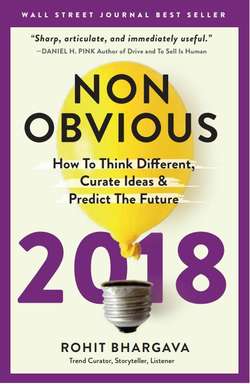Читать книгу Non-Obvious 2018 Edition - Рохит Бхаргава - Страница 19
На сайте Литреса книга снята с продажи.
Why Most Trend Predictions Are Useless
ОглавлениеA few years ago, I picked up the year-end edition of Entrepreneur magazine, which promised to illuminate trends to watch in the coming year. Earlier that same week, a special double issue of BusinessWeek magazine had arrived in the mail making a similar promise.
It was the end of the year and the trend season was in full swing.
Just like New Year’s resolutions to lose weight, trend forecasting is popular in December (one of the reasons why each annual edition of Non-Obvious is usually published in December as well). Unfortunately, the side effect of this annual media ritual is an abundance of lazy predictions and vague declarations.
For entertainment, I collect these year-end trend forecasts and keep them as standing memorials to the volume of pitiful predictions that bombard us as we look to the year ahead.
Here are a few of the worst-offending, most obvious “trends” I’ve seen. For the sake of kindness, I haven’t tagged them with their sources or authors:
“It’s all about the visuals.”
“Streaming video content.”
“The Year of Drones has arrived. Really.”
“Content Marketing will continue to be the place to be.”
“Fantasy Sports”
“Virtual Reality”
“Change will be led by smart home technology.”
Virtual Reality? Really?
Not to ruin the suspense, but I don’t believe any of these should be described as trends. Some are just random buzzwords or the names of platforms. Others are hopelessly broad, useless, and, yes, obvious.
None of them fit my trend definition of a unique idea describing the accelerating present.
Meanwhile, all of us as media consumers read these predictions with varying levels of skepticism. To better understand why, let’s review the four main reasons why most trend predictions fail the believability test.
